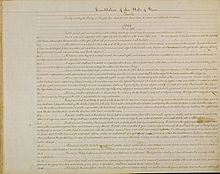
Back Constitución de Texas Spanish قانون اساسی تگزاس Persian Constitution du Texas French Costituzione del Texas Italian Конституция Техаса Russian Конституція Техасу Ukrainian
| Constitution of the State of Texas | |
|---|---|
 The opening of the hand-written Texas Constitution of 1876 | |
| Overview | |
| Jurisdiction | Texas |
| Subordinate to | United States Constitution |
| Government structure | |
| Branches | 3 |
| Chambers | Bicameral |
| Executive | Governor |
| Judiciary | Supreme, Districts |
| Full text | |
The Constitution of the State of Texas is the document that establishes the structure and function of the government of the U.S. state of Texas and enumerates the basic rights of the citizens of Texas.
The current document was adopted on February 15, 1876, and is the seventh constitution in Texas history (including the Mexican constitution). The previous six were adopted in 1827 (while Texas was still part of Mexico and half of the state of Coahuila y Tejas), 1836 (the Constitution of the Republic of Texas), 1845 (upon admission to the United States), 1861 (at the beginning of the American Civil War), 1866 (at the end of the American Civil War), and 1869. Texas constitutional conventions included 1861, 1866, 1868–69, and 1875.[1]
The constitution is the second-longest state constitution in the United States (exceeded only by the Constitution of Alabama, even with the latter being recompiled as a new document in 2022 and having obsolete, duplicative, and overtly racist provisions removed) and is also the third-most amended state constitution (only the Alabama and California constitutions have been amended more often).[2] From 1876 to 2024 (following the 88th Legislature), the Texas Legislature proposed 714 constitutional amendments. Of that total, 530 were approved by the electorate, 181 were defeated, and 3 never made it on the ballot.[3] Most of the amendments are due to the document's highly restrictive nature: the constitution stipulates that the state of Texas has only those powers explicitly granted to it; there is no counterpart of the federal necessary and proper clause.
As with many state constitutions, it explicitly provides for the separation of powers and incorporates its bill of rights directly into the text of the constitution (as Article I). The bill of rights is considerably lengthier and more detailed than the federal Bill of Rights, and includes some provisions not included in the federal Constitution.
- ^ Spaw, Patsy McDonald (1990). The Texas Senate: Civil War to the Eve of Reform, 1861-1889. Texas A&M University Press. ISBN 978-0-89096-857-4.
- ^ "Number of state constitutional amendments in each state". Ballotpedia. Lucy Burns Institute.
- ^ "Constitutional Amendments". Legislative Reference Library of Texas. Texas Legislature. Retrieved September 26, 2024.